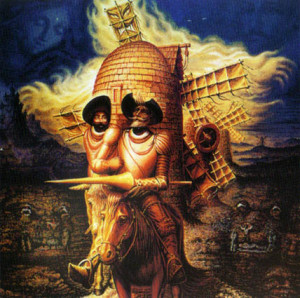Alright, alright, alright. There is a lot to go over, and by no means did we go over it all. I would say there was one main conversation that sparked interest in Tuesday’s book club meeting. In addition to our talks, I have been seeking outside sources to lend insight to the text. If you are interested, please visit the Yale Open Courses website, and in the Spanish department you can find a course on the very Don Quixote. The only pitfall to this resource is that the professor doesn’t use our Edith Grossman. So is the price to pay for a Yale professor.
I will mention a few things I learned from him based on the first two lectures I listened to. These things have to do with our conversations in the book club… so they’re relevant.
In this past reading, there are many moments of great dialogue where either Sancho or Quixote spit out some wisdom and the matter is dropped. I’m thinking specifically the part in our reading when Don Quixote comes across a band of actors and Sancho urges his master not to attack them. Don Quixote listens to Sancho and realizes that stealing their stuff would have brought them nothing, since the gold they wear is fake and the jewels are nothing but cheap replicas. Don Quixote takes it upon himself to make sure Sancho still appreciates the actors even though, “One plays the scoundrel, another the liar, this one the merchant, that one the soldier, another the wise fool,yet another the foolish lover, but when the play is over and they have taken off their costumes, all the actors are equal” (527). Don Quixote then relates this to life and death. That in life we are not equal, but in death all souls are weighed the same. Isn’t that beautiful? especially for the idealist of Don Quixote. To realize such a human truth and to acknowledge that this world is stratified in powerful ways, and that only in death will the human race have true equality.
Things of this truthful nature are spouted like a whale surfacing for air. These pieces of wisdom come and then leave us in the wake of the narrative, and Cervantes doesn’t come back to them. One of my biggest insights into this book was that of questioning God, and now it seems like the book has taken on a different focus. Now, I, we’ve been told this book doesn’t have one specific theme, in fact it eludes any one answer or one key that shines insight to the pure meaning of the work. As far as themes and meaning, not one answer will suffice. All we can say is that the book is about a middle aged man, who consumed by chilvalric romances, sets out on knight errantry to right the world’s wrongs with his loyal squire. As the Professor from Yale put it: a tall, thin idealist sets out with a short, fat realist.
And to be absolutely real, while watching this class, the professor made a very interesting point regarding novels and romances. Now, in the book, Edith Grossman refers to the books Don Quixote read as Chivalric novels. This is inaccurate. What Don Quixote was reading and was possessed by was call Chivalric romances.
Chivalric Romance was a very popular genre back in the 1500s. We still have them today. A romance comes from the culture of Rome, and the key characteristics in this genre of story telling is it is in verse or prose, a long narrative in a romantic dialect, about an adventure of a knight errant in remote location. Also the main characters were always lovers or close friends. And, the most important distinction is that the main character never changes.
Don Quixote deviates from the above definition greatly. In fact almost in every way besides they are both prose works and take place in a remote location. However, Don Quixote is middle aged, his squire is someone he barely knows, and all the characters mentioned, even in the intercalary novels, the main characters change. And in Don Quixote, everything is changing all the time and everywhere.
We can see this in how Don Quixote speaks to the Man in the Green Coat about good art, poetry, technique, and content (Sancho is more intellectual in the Part 2, as well). After the incident with the actors, a man riding a female horse approaches from our duet’s rear and is stopped by Don Quixote. There the man in the coat explains his misfortunes with his son, whom is a poet. Don Quixote rejects the man’s disapproval of his son and urges him to nurture his son’s talent and guide him to be a good poet. In the discussion Don Quixote remarks, “The natural poet who makes use of art will be a much better and more accomplished poet than the one who only knows the art and wishes to be a poet; the reason is that art does not surpass nature but perfects it; therefore, when nature is mixed with art, and art with nature, the result is a perfect poet” (557). So there is a debate on what makes a poet write good poetry. Don Quixote gives his advice to the father in green to be a good parent but also to ensure his son attains honor in his art. His advice consist of instilling virtue, which will lead the son to writing of virtuous things: content. Then advising the father to urge his son to make use of art, technique, and not to simply know it. It is common to say a writer has to have something to say and know how to say it well. To use language beautifully so that we may access his content, the virtue of the prose or verse.
Blaze brought up watercolor. And in the world of watercolor, people are amazed, awed by the technique of the artist. I wasn’t aware of it until she said something, but to look at a really good watercolor is truly amazing. Here’s one that I found on the internet:

The water in this image pops out in a glaze, however the water creeping towards the background reflects clearly the landscape above. The light is properly transformed in the reflection. Almost all good watercolor’s are like this: tranquil, serene, something magical lurking behind each stroke of the brush.
In the context of Don Quixote’s speech, like watercolor, the technique is important. It’s the vehicle in which the virtue or moral is transported. This communication is the experience of art, and once set down on paper or saved as a word doc. it’s message will always be there available for someone to experience, if they are open to the experience.
This technique can take shape in many different ways. We call it style, and in literature style is very important. In Cervantes’s case, style is the foundation of this book. Believe it or not Quixote is a new style, never seen or read. It calls to itself, criticizes the weak and envious, and takes hold of the natural world.
In our meeting, the question that really got us going and learning was: What is a novel?What makes a novel… What does it need to have? Is Don Quixote a novel? Blaze said, A novel is a narrative with a major plot/s and theme/s with sub plots and sub themes. At first she didn’t agree that this was a novel. It certainly isn’t a romance as we earlier discussed. The professor from Yale said it could also be a picaresque, which is an episodic style of fiction dealing with the adventures of a rough and dishonest but appealing hero. He also said a novel is a narrative where the characters change over time. Blaze agreed it could be a picaresque and did not concede to it being a novel. To me however, it’s a novel for the fact that the characters change and the work’s complexity of narrative and experimentation. This book is a total break in tradition. It ignores every rule there is. This happens ever 100 years starting with Don Quixote in 1605, Defoe 1710 introducing individualism in capitalism, Jan Austen in 1800 with marriage plots, then Joyce and Woolf in 1900, and the only work I can think of close to 2000 that breaks bounds is Infinite Jest, David Foster Wallace.
This book, Don Quixote, is allusive in the number of frame tales or worlds that we as readers experience. From the real world into fiction, there is our world in which we are reading this book, then there is Cervantes world in which he is writing the book, i.e. prologue’s and notes, then there is the narrator who is uncovering and transcribing these adventures, then there is the world of the writer who writes Quixote’s adventures, a Moor named Cide something, then there is the world in which Sancho and the other characters of the book live: a reality close to the one we live/lived in, then there is Don Quixote’s world where wind mills are giants and sheep are armies. No matter how we cut it, there is always some twist, some level of separation from real and imaginary. We are always in some projection of someone else’s imagination. We know this is a work of fiction: Don Quixote never existed. However the author of the story goes about the narrative, fixing mistakes and referring to the real world as if he did. This book seems to be about projections and belief and subjectivity of reality and how art functions in our world honestly or dishonestly. Perhaps that’s why it’s a work of infinite and immortal genius. Beating time itself.
The Writing Lab

